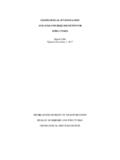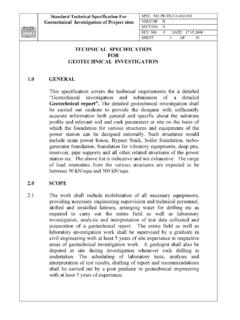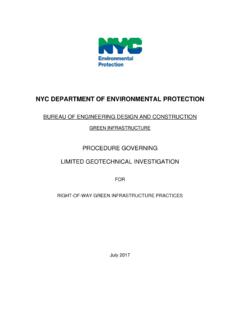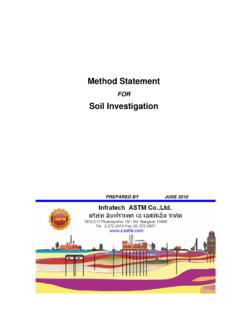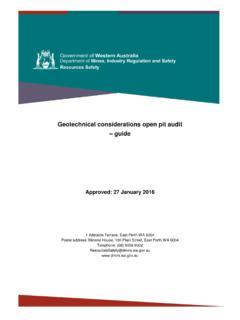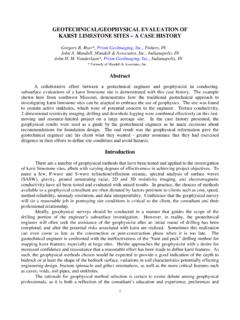Transcription of 87 - Food and Agriculture Organization
1 877. BreakwatersSUMMARYA breakwater is a structure constructed for the purpose of forming an artificial harbour with a basin so protected from the effect of waves as to provide safe berthing for fishing vessels. There are many different types of breakwaters; natural rock and concrete, or a combination of the two, are the materials which form 95 percent or more of all the breakwaters chapter reviews the various cross-sections of the most common types of breakwaters and their method of construction. It does not go into great detail with regard to the design of breakwaters as this is best left to the professional engineers for specific applications. Nevertheless, a brief description of the design requirements is given for the sake of clarity.
2 The reader, however, will be well able to understand the different typologies of breakwaters in use nowadays and appreciate the complexity of choice and underwater construction. Fishing harbour planning construction and for the construction of a needs and further PARAMETERS FOR THE COnSTRUCTIOn OF A BREAKWATERWhen a breakwater is to be built at a certain location, and the environmental impact of such a structure has already been evaluated and deemed environmentally feasible, the following parameters are required before construction can commence: a detailed hydrographic survey of the site; a geotechnical investigation of the sea bed; a wave height investigation or hindcasting; a material needs assessment; and the cross-sectional design of the Hydrographic surveyThe hydrographic survey that is described in Chapter 5 is required for the calculation of the volumes of material required for the geotechnical investigationA geotechnical investigation of the sea bed is required to determine the type of founding material and its extent.
3 The results of this investigation will have a direct bearing on the type of cross-section of the breakwater. In addition, it is essential to determine what the coastline consists of, for example: soft or hard rock (like coral reefs or granite); sand (as found on beaches); clay (as in some mangrove areas); and soft to very soft clay, silt or mud (as found along some river banks, mangroves and other tidal areas).In the event that the harbour basin is to be formed by the breakwater itself, a proper advanced site investigation by a specialist contractor is recommended, particularly when project cost is expected to be considerable. On the other hand, if the proposed breakwater structure has no direct bearing on the outcome of a project (for example, if the breakwater is an added protection to a natural inlet) and if it is to be executed on an artisanal scale, then simple basic investigations may Basic geotechnical investigationsBasic geotechnical investigations normally suffice for small or artisanal projects, especially when the project site is remote and access poor.
4 A basic geotechnical investigation should be carried out or supervised by an experienced engineer or geologist familiar with the local soil conditions. The following activities may be carried out in a basic investigation using only portable equipment: retrieval of bottom sediments for laboratory analysis; measurement of bottom layer (loose sediment) thickness; and approximate estimation of bearing capacity of the sea equipment required to carry out the above-mentioned activities consists of a stable floating platform (a single canoe is not stable enough, but two canoes tied together to form a catamaran are excellent), diving equipment, a Van Veen bottom sampler (may be rented from a national or university laboratory), a 20 mm diameter steel pricking rod and a water lance (a 20 mm diameter steel pipe connected to a gasoline-powered water pump).
5 Before the start of any work, the area to be investigated should be marked via a set of marker buoys or a scaffold pipe frame placed on the sea bed and the exact coordinates noted for future reference. To retrieve samples from the sea bed, a Van Veen hand-operated bottom sampler is required, Figure 1. Simply picking up samples from the sea Fishing harbour planning, construction and management90bed with a scoop or bucket disturbs the sediment layers with the eventual loss of the finer material and is not a recommended method. The sediments thus collected should then be carefully placed in wide-necked glass jars and taken to a national or university laboratory for analysis. At least 10 kilograms of sediment are normally required by the laboratory for a proper , a good hard bottom is overlain by a layer of loose or silty sand or mud.
6 In most cases this layer has to be removed by dredging to expose the harder material underneath. To determine the thickness of this harder layer, a water lance is required. This consists of a length of steel tubing (the poker), sealed at the bottom end with a conical fitting and connected to a length of water hose at the top end. The water hose is connected to a small gasoline-powered water pump drawing seawater from over the side of the platform. The conical end has four 3 mm diameter holes drilled into it. The diver simply pokes the steel tube into the sediment while water is pumped into it from above until the poker stops penetrating, Figure 2. The diver then measures the penetration. This method, also known as pricking, works very well in silty and muddy deposits up to 2 to 3 metres thick.
7 It is not very effective in very coarse sand with large 1 The Van Veen bottom samplerWINCHSTABLE PLATFORMMARKER BUOYSMARKER BUOYSMEAN SEA LEVELVAN VEEN HAND-OPERATED GRAB FIGURE 2 The water lance used to prick the sea bedSTABLE PLATFORMGASOLINE-POWERED WATER PUMPMEAN SEA LEVELSEA WATER PUMPED INTO PIPE25 mm WATER HOSE20 mm DIAMETER STEEL PIPESCAFFOLD PIPE FRAMEEND CONE WITH 4 X 3 mm DIAMETER HOLESB reakwaters91 Once the layer of soft sediment has been identified (sampled) and measured (pricked), it is then necessary to determine the hardness of the underlying layer. The underlying layer may be rock, clay or compacted sand. If the layer is rocky, the diver should collect a piece of the material for laboratory analysis using a hammer and chisel. For softer types of material, the diver (with a submerged weight of around 10 kilograms) should use a steel probe (1 metre long, 12 millimetres in diameter) or pocket penetrometer, Figure 3.
8 An area of around 300 mm square should be cleaned of loose sediment and the probe or penetrometer placed vertically over it. The 10-kilogram exertion on the probe will cause the probe to penetrate into the material. The diver then notes the penetration for the engineer to estimate the bearing capacity. If a pocket penetrometer is used, the bearing capacity may be read off the penetrometer scale Advanced geotechnical investigationsAn advanced geotechnical investigation normally requires the retrieval of undisturbed core samples, Figure 4, taken from the level of the sea bed down to a depth ranging from 10 to 30 metres, depending on the type of structure envisaged and the ground conditions obtaining at the geotechnical investigations are normally carried out by specialist contractors or soil laboratories and require a mobile drilling rig.
9 The drilling rig can travel to most destinations but must be installed on a stable platform before it can be used to drill for cores over water, Figure 5. FIGURE 3 Estimating the bearing capacity of the foundationA POCKET PENETROMETERMEAN SEA LEVELDIVER WEIGHT IN WATERAROUND 10 KG20 mm DIAMETER STEEL RODSCAFFOLD PIPE FRAMEFIGURE 4 Core samples of hard clay retrieved from 15 metres below sea bedFishing harbour planning, construction and Wave hindcastingThe height of wave incident on a breakwater generally determines the size and behaviour of the breakwater. It is hence of the utmost importance to obtain realistic values of the waves expected in a particular area. Behaviour of water waves is one of the most intriguing of nature s phenomena.
10 Waves manifest themselves by curved undulations of the surface of the water occurring at periodic intervals. They are generated by the action of wind moving over a waterbody; the stronger the wind blows, the higher the waves generated. They may vary in size from ripples on a pond to large ocean waves as high as 10 generated waves cause the most damage to coastal structures and if winds of a local storm blow towards the shore, the storm waves will reach the shore or beach in nearly the form in which they were generated. However, if waves are generated by a distant storm, they travel hundreds of miles of calm sea before reaching the shore as swell. As waves travel across the sea they decay (they loose energy and get smaller and smaller) and only the relatively larger waves reach the shore in the form of disturbance is also felt to a considerable depth and, therefore, the depth of water has an effect on the character of the wave.










